+ Open data
Open data
- Basic information
Basic information
| Entry | Database: PDB / ID: 7t6o | |||||||||
|---|---|---|---|---|---|---|---|---|---|---|
| Title | Cryo-EM structure of TRPV5 in nanodiscs at pH6 state 3 | |||||||||
 Components Components | Transient receptor potential cation channel subfamily V member 5 | |||||||||
 Keywords Keywords |  TRANSPORT PROTEIN / TRANSPORT PROTEIN /  Calcium / Calcium /  Ion channel / Ion channel /  Kidney Kidney | |||||||||
| Function / homology |  Function and homology information Function and homology informationregulation of urine volume / calcium ion import across plasma membrane / calcium ion homeostasis / calcium ion transmembrane transport /  calcium channel activity / calcium ion transport / protein homotetramerization / calcium channel activity / calcium ion transport / protein homotetramerization /  calmodulin binding / apical plasma membrane / identical protein binding ...regulation of urine volume / calcium ion import across plasma membrane / calcium ion homeostasis / calcium ion transmembrane transport / calmodulin binding / apical plasma membrane / identical protein binding ...regulation of urine volume / calcium ion import across plasma membrane / calcium ion homeostasis / calcium ion transmembrane transport /  calcium channel activity / calcium ion transport / protein homotetramerization / calcium channel activity / calcium ion transport / protein homotetramerization /  calmodulin binding / apical plasma membrane / identical protein binding / calmodulin binding / apical plasma membrane / identical protein binding /  metal ion binding / metal ion binding /  plasma membrane plasma membraneSimilarity search - Function | |||||||||
| Biological species |   Oryctolagus cuniculus (rabbit) Oryctolagus cuniculus (rabbit) | |||||||||
| Method |  ELECTRON MICROSCOPY / ELECTRON MICROSCOPY /  single particle reconstruction / single particle reconstruction /  cryo EM / Resolution: 2.6 Å cryo EM / Resolution: 2.6 Å | |||||||||
 Authors Authors | Fluck, E.C. / Yazici, A.T. / Rohacs, T. / Moiseenkova-Bell, V.Y. | |||||||||
| Funding support |  United States, 2items United States, 2items
| |||||||||
 Citation Citation |  Journal: Cell Rep / Year: 2022 Journal: Cell Rep / Year: 2022Title: Structural basis of TRPV5 regulation by physiological and pathophysiological modulators. Authors: Edwin C Fluck / Aysenur Torun Yazici / Tibor Rohacs / Vera Y Moiseenkova-Bell /  Abstract: Transient receptor potential vanilloid 5 (TRPV5) is a kidney-specific Ca-selective ion channel that plays a key role in Ca homeostasis. The basal activity of TRPV5 is balanced through activation by ...Transient receptor potential vanilloid 5 (TRPV5) is a kidney-specific Ca-selective ion channel that plays a key role in Ca homeostasis. The basal activity of TRPV5 is balanced through activation by phosphatidylinositol 4,5-bisphosphate (PI(4,5)P) and inhibition by Ca-bound calmodulin (CaM). Parathyroid hormone (PTH), the key extrinsic regulator of Ca homeostasis, increases the activity of TRPV5 via protein kinase A (PKA)-mediated phosphorylation. Metabolic acidosis leads to reduced TRPV5 activity independent of PTH, causing hypercalciuria. Using cryoelectron microscopy (cryo-EM), we show that low pH inhibits TRPV5 by precluding PI(4,5)P activation. We capture intermediate conformations at low pH, revealing a transition from open to closed state. In addition, we demonstrate that PI(4,5)P is the primary modulator of channel gating, yet PKA controls TRPV5 activity by preventing CaM binding and channel inactivation. Our data provide detailed molecular mechanisms for regulation of TRPV5 by two key extrinsic modulators, low pH and PKA. | |||||||||
| History |
|
- Structure visualization
Structure visualization
| Structure viewer | Molecule:  Molmil Molmil Jmol/JSmol Jmol/JSmol |
|---|
- Downloads & links
Downloads & links
- Download
Download
| PDBx/mmCIF format |  7t6o.cif.gz 7t6o.cif.gz | 427.5 KB | Display |  PDBx/mmCIF format PDBx/mmCIF format |
|---|---|---|---|---|
| PDB format |  pdb7t6o.ent.gz pdb7t6o.ent.gz | 346.2 KB | Display |  PDB format PDB format |
| PDBx/mmJSON format |  7t6o.json.gz 7t6o.json.gz | Tree view |  PDBx/mmJSON format PDBx/mmJSON format | |
| Others |  Other downloads Other downloads |
-Validation report
| Arichive directory |  https://data.pdbj.org/pub/pdb/validation_reports/t6/7t6o https://data.pdbj.org/pub/pdb/validation_reports/t6/7t6o ftp://data.pdbj.org/pub/pdb/validation_reports/t6/7t6o ftp://data.pdbj.org/pub/pdb/validation_reports/t6/7t6o | HTTPS FTP |
|---|
-Related structure data
| Related structure data |  25721MC 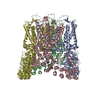 7t6jC 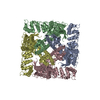 7t6kC 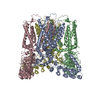 7t6lC 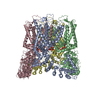 7t6mC 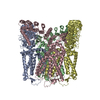 7t6nC 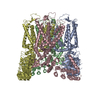 7t6pC 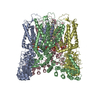 7t6qC 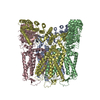 7t6rC M: map data used to model this data C: citing same article ( |
|---|---|
| Similar structure data | Similarity search - Function & homology  F&H Search F&H Search |
- Links
Links
- Assembly
Assembly
| Deposited unit | 
|
|---|---|
| 1 |
|
- Components
Components
| #1: Protein | Mass: 83784.586 Da / Num. of mol.: 4 Source method: isolated from a genetically manipulated source Details: Rabbit TRPV5 with c-terminal 1D4 epitope tag / Source: (gene. exp.)   Oryctolagus cuniculus (rabbit) / Gene: Trpv5, Ecac1 / Production host: Oryctolagus cuniculus (rabbit) / Gene: Trpv5, Ecac1 / Production host:   Saccharomyces cerevisiae (brewer's yeast) / References: UniProt: Q9XSM3 Saccharomyces cerevisiae (brewer's yeast) / References: UniProt: Q9XSM3 |
|---|
-Experimental details
-Experiment
| Experiment | Method:  ELECTRON MICROSCOPY ELECTRON MICROSCOPY |
|---|---|
| EM experiment | Aggregation state: PARTICLE / 3D reconstruction method:  single particle reconstruction single particle reconstruction |
- Sample preparation
Sample preparation
| Component | Name: Tetrameric assembly of TRPV5 ion channel reconstituted into lipid nanodiscs Type: COMPLEX / Entity ID: all / Source: RECOMBINANT |
|---|---|
| Molecular weight | Experimental value: NO |
| Source (natural) | Organism:   Oryctolagus cuniculus (rabbit) Oryctolagus cuniculus (rabbit) |
| Source (recombinant) | Organism:   Saccharomyces cerevisiae (brewer's yeast) / Plasmid Saccharomyces cerevisiae (brewer's yeast) / Plasmid : YEp : YEp |
| Buffer solution | pH: 6 |
| Specimen | Embedding applied: NO / Shadowing applied: NO / Staining applied : NO / Vitrification applied : NO / Vitrification applied : YES : YES |
| Specimen support | Grid material: COPPER / Grid mesh size: 300 divisions/in. / Grid type: Quantifoil R1.2/1.3 |
Vitrification | Instrument: FEI VITROBOT MARK IV / Cryogen name: ETHANE / Humidity: 100 % / Chamber temperature: 277.15 K |
- Electron microscopy imaging
Electron microscopy imaging
| Experimental equipment |  Model: Titan Krios / Image courtesy: FEI Company |
|---|---|
| Microscopy | Model: FEI TITAN KRIOS |
| Electron gun | Electron source : :  FIELD EMISSION GUN / Accelerating voltage: 300 kV / Illumination mode: FLOOD BEAM FIELD EMISSION GUN / Accelerating voltage: 300 kV / Illumination mode: FLOOD BEAM |
| Electron lens | Mode: BRIGHT FIELD Bright-field microscopy / Nominal magnification: 105000 X / Nominal defocus max: 2500 nm / Nominal defocus min: 500 nm / Cs Bright-field microscopy / Nominal magnification: 105000 X / Nominal defocus max: 2500 nm / Nominal defocus min: 500 nm / Cs : 2.7 mm : 2.7 mm |
| Specimen holder | Cryogen: NITROGEN / Specimen holder model: FEI TITAN KRIOS AUTOGRID HOLDER |
| Image recording | Electron dose: 42 e/Å2 / Film or detector model: GATAN K3 (6k x 4k) / Num. of grids imaged: 1 / Num. of real images: 11244 |
- Processing
Processing
| Software |
| ||||||||||||||||||||||||||||||||||||
|---|---|---|---|---|---|---|---|---|---|---|---|---|---|---|---|---|---|---|---|---|---|---|---|---|---|---|---|---|---|---|---|---|---|---|---|---|---|
| EM software |
| ||||||||||||||||||||||||||||||||||||
CTF correction | Type: PHASE FLIPPING AND AMPLITUDE CORRECTION | ||||||||||||||||||||||||||||||||||||
| Particle selection | Num. of particles selected: 1772051 | ||||||||||||||||||||||||||||||||||||
| Symmetry | Point symmetry : C4 (4 fold cyclic : C4 (4 fold cyclic ) ) | ||||||||||||||||||||||||||||||||||||
3D reconstruction | Resolution: 2.6 Å / Resolution method: FSC 0.143 CUT-OFF / Num. of particles: 172497 / Symmetry type: POINT | ||||||||||||||||||||||||||||||||||||
| Atomic model building | Space: REAL | ||||||||||||||||||||||||||||||||||||
| Refinement | Cross valid method: NONE Stereochemistry target values: GeoStd + Monomer Library + CDL v1.2 | ||||||||||||||||||||||||||||||||||||
| Displacement parameters | Biso mean: 34.23 Å2 | ||||||||||||||||||||||||||||||||||||
| Refine LS restraints |
|
 Movie
Movie Controller
Controller












 PDBj
PDBj

